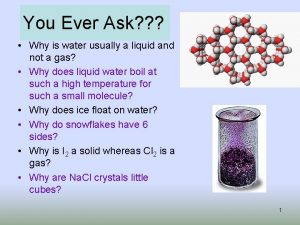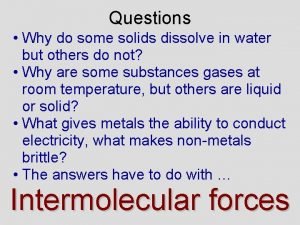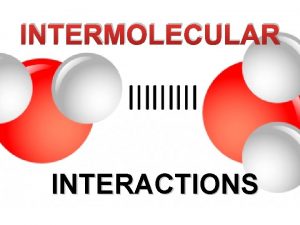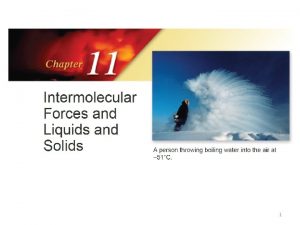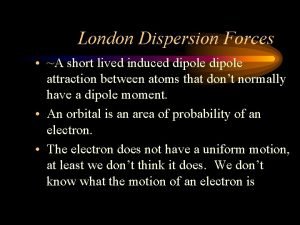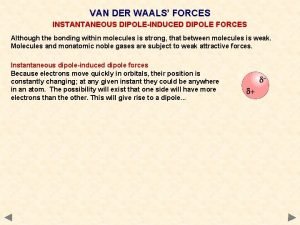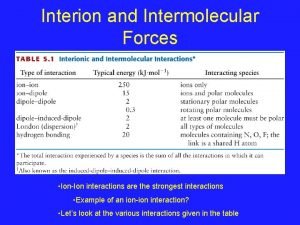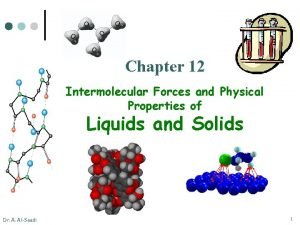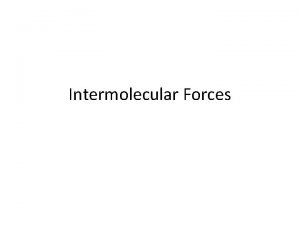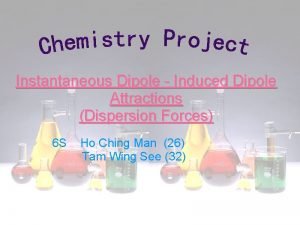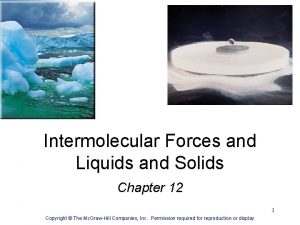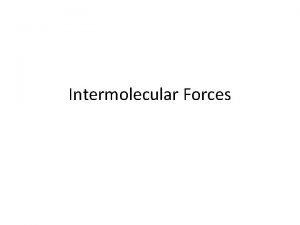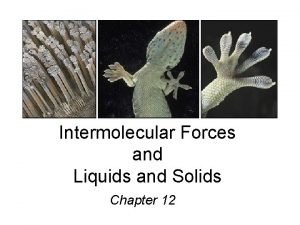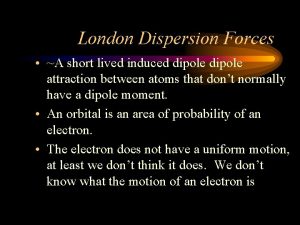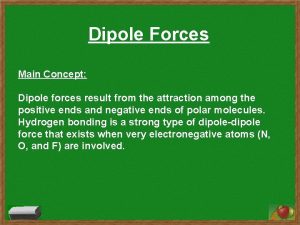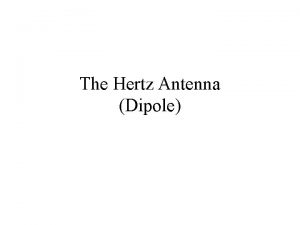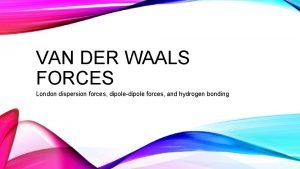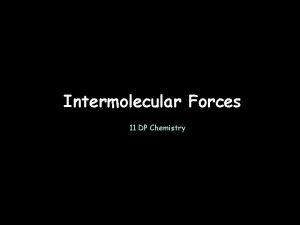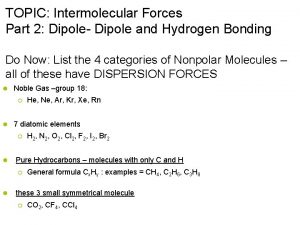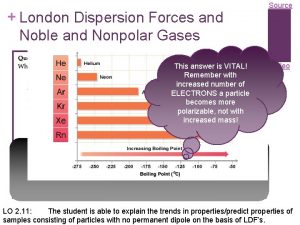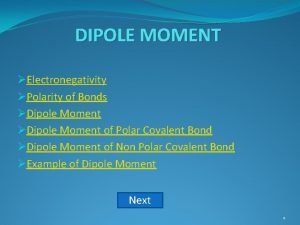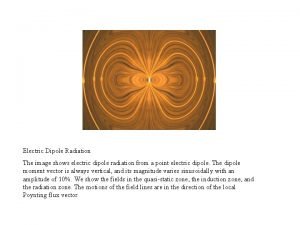London Dispersion Forces A short lived induced dipole



















- Slides: 19

London Dispersion Forces • ~A short lived induced dipole attraction between atoms that don’t normally have a dipole moment. • An orbital is an area of probability of an electron. • The electron does not have a uniform motion, at least we don’t think it does. We don’t know what the motion of an electron is

Probability • Flip a coin 2 times, should you get 1 heads and 1 tails? • Not really. There is a chance you will but, but it is only the highest probability. • You have a 50% chance of getting 1 heads 1 tails, 25% chance of getting 2 heads and 25% chance of getting 2 tails. • Apply that to our atom…

Helium Positive nucleus with 2 electrons in a 1 s orbital. It is neutral because the negative electrons cancel out the positive charges. Imagine a line cutting the orbital in half. What is the probability the electron is on either side? 50/50, but just like the coin flip should we always expect to find 1 electron on either side? No. However, if we don’t…

Still Helium - + None on this 2 electrons side. on this side. This side is now negative. now positive. Put this atom near another atom. . . - + The positive side will + attract the electrons, increasing the chance of poles forming again. It not only forces another atom to have poles, but the “new” atom forces the original to keeps its poles.

London Forces • This force is random and short lived, as the electrons do constantly move, and will eventually end the dipole moment. • It is also fairly weak. • You can tell it is really weak in helium because it stays a gas until -268. 9 o C. • Larger atoms or molecules (with more electrons) have stronger London forces. • With more electrons it is easier for the atom or molecule to have its electrons unbalanced and stay that way for an extended period of time. • Iodine (I 2) is a solid at room temperature.

Evaporation and Vaporization

Evaporation • Evaporation is a change in phase from liquid to gas, but is not the same as vaporization! • Vaporization requires you to heat the substance to its boiling point. • Evaporation can happen at much lower temperatures. • Volatility- A measure of how easily a liquid evaporates.

Is the vapor above the boiling point? • No it is not! (water vapor is not +100 o C) • It is possible to get matter in a phase that its temperature does not agree with. • It is like a solution (dissolved water in air) • It is also possible to get liquids above or below their freezing points. (supercooled or superheated liquids)

Evaporation works like this Liquids have molecules moving around in them Temperature is the average kinetic energy (which depends on the speed) If they are of these molecules. moving fast Some are moving enough, at just faster than others! the right angle, some will escape Molecules are held the surface of the in by liquid intermolecular and turn into a gas. forces. These evaporated!

Why are they a “gas” • Intermolecular forces determine whether something is a solid liquid or gas. • In order to have intermolecular forces you need to have multiple particles. • The ones that escaped aren’t next to any other particles. • Since they have almost no intermoleluar forces they have to be a gas.

Where did they go? • They are in the air around the liquid. • They are called vapors, anything that naturally is a solid or liquid under standard conditions that is currently a gas at standard conditions. • If enough of them get together they will condense and reform a liquid. • As more of the molecules evaporate and fill the air around the liquid, the chance that some of them may condense increases. • Provided the vapors can’t escape, the liquid will reach a state where the rate of condensation and evaporation equal each other.

Vapor Pressure • Vapor Pressure of a substance is the pressure of the vapor required for the rate of evaporation and condensation to be the same. • At this pressure the substance will reach a dynamic equilibrium. • Dynamic means changing, equilibrium means staying the same. • At a molecular level, constantly molecules are evaporating and condensing. However, since these cancel out, there is not net change.

After a liquid evaporates • The remaining liquid is cooler. • This is because the molecules with the most kinetic energy (heat) escaped. • Water has a “cooling” effect because it evaporates. • Sweat cools your body by evaporation. • Provided it is not humid out. • Humidity is a measure of the amount of water vapor present in the air.

Muggy (humid) weather • In humid weather, the water vapor in the air is closer to its vapor pressure. • Less net water can evaporate, and cool you off. • The rate of evaporation hasn’t changed, but more water vapor is condensing than normally.

Increasing Evaporation • Intermolecular forces play a big part. • Low molecular forces mean the substance will easily evaporate. These substances are volatile. • Evaporation occurs at the surface of a liquid so increasing the surface area will increase the rate of evaporation. • Allow evaporated vapors to escape so it can’t reach vapor pressure. • Heat the substance to increase to kinetic energy.

Why do fans/wind feel cool? • The majority of the water vapor from your sweat is directly around you. • A fan or wind pushes air from somewhere else over to you, and the air that was around you somewhere else. • The water vapor that evaporated can’t condense back on you. • This only works if it isn’t extremely humid out. • If it is extremely humid the air from somewhere else contains a lot of water vapor that will condense on you.

Vaporization or Boiling • Evaporation occurs at the surface of a liquid. • As you continually heat a liquid, the particles inside move faster. • Eventually the particles move so quickly, that they break free of all intermolecular forces and form gas pockets inside of liquid. • These are always less dense than the liquid so the float to the surface and escape. • This is vaporization or boiling.

Evaporation and Vaporization Evaporation occurs at the surface If I get the substance hot enough

Evaporation and Vaporization This is vaporization or boiling I can force gas bubbles to form in the middle of the liquid
 London dispersion forces induced dipole
London dispersion forces induced dipole London dispersion forces induced dipole
London dispersion forces induced dipole How do london dispersion forces work
How do london dispersion forces work Ion induced dipole example
Ion induced dipole example Surface tension intermolecular forces
Surface tension intermolecular forces Dispersion forces vs dipole dipole
Dispersion forces vs dipole dipole Dispersion forces vs dipole dipole
Dispersion forces vs dipole dipole Van der waals forces
Van der waals forces Ion-dipole interaction example
Ion-dipole interaction example Long and short
Long and short A topaz crystal has an interplanar spacing
A topaz crystal has an interplanar spacing London dispersion forces hydrocarbons
London dispersion forces hydrocarbons Intermolecular forces london dispersion
Intermolecular forces london dispersion What is instantaneous dipole
What is instantaneous dipole Ion induced dipole examples
Ion induced dipole examples Intermolecular forces of attraction
Intermolecular forces of attraction Strength of intermolecular forces
Strength of intermolecular forces Intermolecular forces in dimethyl ether
Intermolecular forces in dimethyl ether Intermolecular forces of attraction
Intermolecular forces of attraction Liquid properties
Liquid properties
